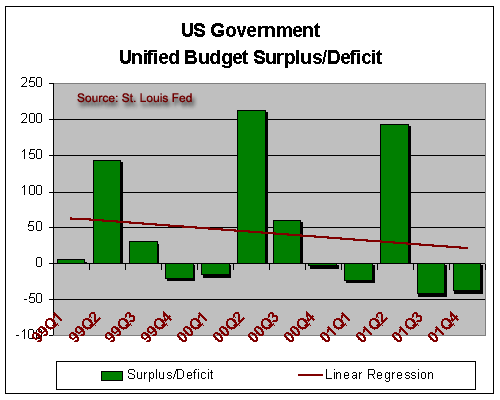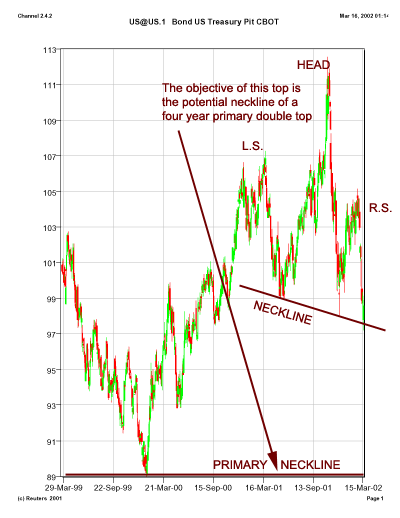|
The Bush administration has been
undermining the pillars of dollar policy under the management of
his associates - Mr. O'Neill and Mr. Greenspan - even long before
adopting the phrase 'free markets determine foreign exchange
rates' (paraphrase).
Since last March as the Treasury
and Fed were engaged in a policy that was aimed at slowing down
the rise in commodity prices, and the fall in asset values, the
President had already been allowing the Unified Budget Surplus to
dwindle.
Greenspan and O'Neill's strategy,
we surmised, was that while the Fed pushed down on interest rates,
Mr. O'Neill would continue to talk up the dollar's potential, thereby
creating price pressures in key commodity markets, or it could have
been the other way around - by pressuring commodity prices, the
dollar could stay strong, and monetary policy could work to inflate
the investment premium on dollar denominated assets.
We argued that O'Neill was the perfect
pick for the job because this way they had the element of surprise
in their favor. The entire world expected Mr. O'Neill to pursue
a weak dollar policy because he was Chairman of Alcoa you see.
But as self-correcting mechanisms
go since monetary policy still failed to reverse the shock to the
economy from sliding stock prices and business capital expenditures,
for most of 2001, fiscal policy kicked in to pick up the slack.
The result was a dwindling budget surplus that even until today
the Treasury insists is a brief phenomenon.
<Please
note that our use of the Government's term "Surplus,"
unified or otherwise, in no way infers an endorsement of the validity
of their calculation. The fact of the matter is that the total
debt of the US government has grown regardless of their revised
definition of the factors contributing to it. However, be that
as it may, we have assumed that to most people today, the government's
numbers are as valid as any. So in order for our message to reach
the broadest audience possible we thought it would be appropriate
at this point to illustrate that even the government's most hedonic
data series are worsening.>

In reality, Bush's economic policy
has been at odds with the Treasury/Fed's strategy from day one,
which means it has been at odds with dollar policy since day one.
Thus, March resulted in the left
shoulder of the 12 month topping formation (in the Treasury bond)
technical analysts refer to as a head and shoulders formation (see
chart below).
Note in the chart also that by June
last year, bond prices turned back up. That was coincident with
a downturn in equity prices, which were to begin their next bear
leg that ended 3000 points lower for the Dow and 300 points lower
for the S&P500.
What bond market wouldn't rally on
that, particularly as commodity prices slide, and as the Fed lowers
short-term interest rates by 75% on a firm dollar?
Still, the budget surplus did not
return, and Larry Summer's promise a year earlier, of a buy back
scheme targeting the long bond, was becoming less believable to
the bond market. Now this was the real problem revealed to the Treasury
after the bombing of the WTC towers on September 11th, 2001, because
even while the Fed slashed the Fed Funds rate another 50% after
that (to 1.75%), and commodity prices as well as government price
indexes sunk to their 1998 lows, Treasury yields continued to stay
stuck (high).
This in turn is partly why credit
spreads didn't really grow through 2001 even though the secondary
bond markets had to contend with growing default rates.
So concurrent with Enron's belated
bankruptcy disclosure, on October 31, 2001 the undersecretary of
the Treasury Peter Fisher announced a scheme that would involve
suspending the issuance of the 30-year government long bond. This
was the advice given to the President as being the best way to keep
borrowing costs low.
The combination of that implication
along with the sudden perception of scarcity that was engendered
in the 30 year drove yields down sharply. In the above chart, this
was the HEAD of the pattern we referred to earlier, and it was the
method by which the Treasury was temporarily able to unstick the
sticky bond yield.
What a coup for dollar policy! The
reason Fisher claimed borrowing costs would stay low is due to the
affect this announcement would have on long-term interest rates.
He further argued that when the surplus
returns to displace the temporary deficit he would be vindicated
of any interim errors resulting from that judgment. But he probably
didn't count on how crowded the medium to short term debt markets
could become, and he probably didn't see the stimulus to commodity
prices resulting from the then current decline in yields.
After all, November was the precise
bottom in the CRB and other commodity indexes as well. Finally,
he probably didn't see how much credibility the scheme would cost.
What you're reading about is the
battle by the Fed and Treasury to keep yields low, while the economy
has time to heal itself. You're reading about market manipulation
at its highest level, where the masters of the universe are above
the laws preventing the rest of us from swindling our neighbor.
The lower interest rates helped fuel
consumption, but at the cost of credit quality and further dislocations
in capital structure, all of last year. Meanwhile, none of these
maneuvers helped profits come back, and the value of stock prices
surged as much as another 50% in the case of the S&P 500.
That's right, the simple PE ratio
went from 27 times earnings to better than 40 times trailing earnings
today. This valuation spike was the direct result of lowering interest
rates below the level at which savings and consumption were in equilibrium,
thereby superficially inflating investment expectations while concurrently
deflating inflation expectations, and thus sustaining the low equity
risk premium.
I bet you couldn't say that ten
times real fast.
However, lower interest rates also
brought on bond supply. Within a month, Fisher's strategy had backfired.
Greenspan's own argument for dwindling long-term Treasury supplies
became a warning to Congress and the President, commodity prices
surged, and yields continued to rise until late December when stock
prices weakened again.
The December/January capitulation
in stock prices kept yields from rising further, but now, stock
bulls have been working themselves up about confidence surveys,
housing activity, and the interim manufacturing data. For the moment
their eye is off the valuation ball.
Equity bear market parameters are
largely still in place, technically speaking, but there is tremendous
excitement that the Fed's stimulus has finally begun to work.
However, the dollar has been troubling
to us all along because it is supported largely by an inflated set
of expectations about future dollar denominated returns. What's
more is that while the dollar was still up against most currencies
last year, it was the first year in its six-year bull market where
it was outperformed by gold prices.
The most recent peak in the dollar
index occurred at the end of January, roughly as the Dow's cyclical
leadership began to develop into the current mini-mania, as if the
market was privy to the Bush administration's coming steel import
tariff news.
In fact, even during early February
I had a sense that the cyclicals were discounting a weak dollar
policy.
Regardless how terrific the economic
data looks today (it really doesn't by the way) stock prices themselves
are considered to be a leading indicator. And their valuation could
be an obstacle to full fledged economic recovery. Should something
happen to reassert the bear market's stranglehold on stock market
confidence these very same indicators will not look as good.
Of course, nothing helps the bear
come out of hibernation like the smell of fresh fear, or concern
about valuations.
And nothing focuses investors on
the problem of valuation like changing relationships between interest
rates, currencies, and commodity prices.
This week, global bond markets all
fell out of major topping patterns. The long term Gilts, the Euro
bunds, US Municipal bonds, as well as the thirty-year Treasury bond
(though the break is clearer in all the others besides the US long
bond) all followed the Japanese government bond in reversing their
2-year intermediate bull markets.
The catalyst? A shift in US trade
policy that threatens to ignite a global trade war. A rising tide
of protectionism is bearish for the dollar and bond since the US
leadership position on trade is one of the key pillars of
dollar policy.
The willingness of foreign investors
to fund the ongoing US current account deficit is in jeopardy as
their biggest incentives (the ability to engage in competitive currency
devaluations for the benefit of trade, and accumulate appreciating
dollar reserves) have been markedly altered. It doesn't matter whether
the US has the right under a world trade agreement because of a
surge in imports. If the owners of US bonds feel as if they've been
slighted, they set the rules, not the WTO.
The world trading and banking community
is in an uproar over the US steel tariffs.
We'll just have to wait and see if
those cyclicals can continue to lead equities higher, amidst a collapsing
dollar, and bond prices. I suspect that by Tuesday of this week,
when the EU and US meet, we'll have an idea of whether foreign exchange
markets are going to adjust the chronic current account deficit,
and how quickly.
But I have a feeling too that President
Bush was serious when he said that the free markets determine foreign
exchange rates. I have a feeling that despite Greenspan and O'Neill's
wishes to the contrary, Bush has already abandoned the strong dollar
policy.
I believe this is what concerns Treasury
markets today. But I think it will concern equity markets tomorrow.
Good luck,
Ed Bugos
|

